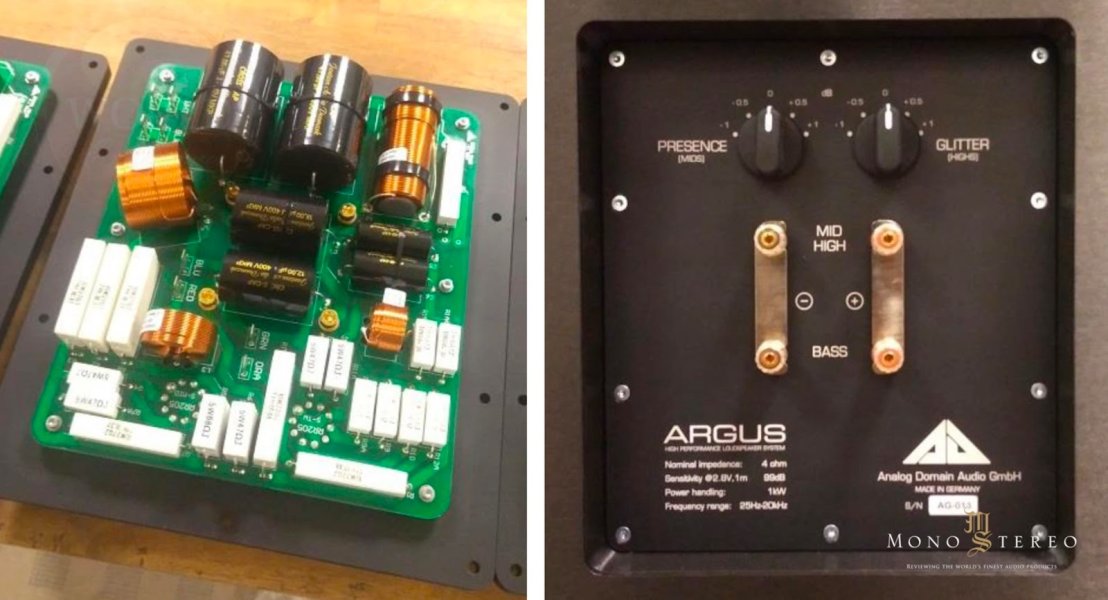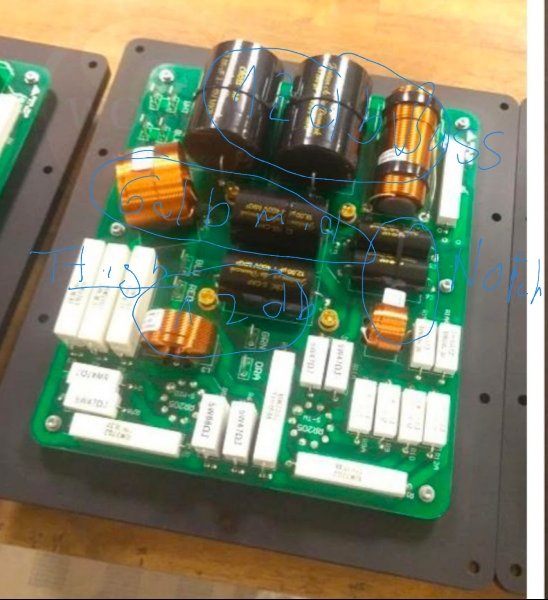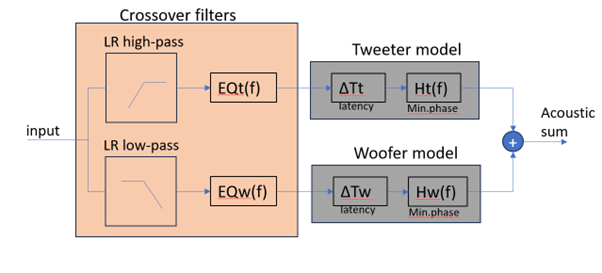Why are you always going so far off topic? The discussion was about Grandinote Mach 8XL bass vs. WA Sasha bass. Why do you put up a DIY speaker?? For whom is this information for? Not for me surely and also not for the OP. Maybe to stay on topic, you should comment on how Grandinote is getting deep bass from 8 x 6.5 inch drivers. It is some kind of hybrid between a transmission line and a reflex but it is not quite either. Perhaps comment on the fact that the Stereophile measurement is down like 10dB or more at 20Hz, despite the port being tuned at around 27Hz. All speakers benefit from room gain, not just Wilsons.Well, you shouldn't expect miracles from an 8" woofer. fs ~ 40Hz is perfectly fine. With a clever housing and bass reflex calculations, you can even get ~27Hz. Whether it makes sense to operate well below fs of driver is something everyone has to decide for themselves. On the other hand, how often do you hear 27Hz and lower tones in music?
P.S
I would listen to the Argus speaker; it's in a different league when it comes to drivers, and the sensitivity is significantly higher.View attachment 161015
Grandinote Mach 8 XL vs Mach 9 speakers
- Thread starter abeidrov
- Start date
You are using an out of date browser. It may not display this or other websites correctly.
You should upgrade or use an alternative browser.
You should upgrade or use an alternative browser.
Probably very few of them out there and possibly only made to order.Same here, I’d really like to hear them. But from what I’ve seen, Max usually demos the Mach 9, Mach 8, Estrema, or Mach 2 at shows. I don’t recall ever seeing the bigger models like the Mach 16 being used in a demo yet.
I didn't say anything about DIY, the Argus speaker costs the same as the Wilson, I just wanted to suggest an alternative. What's interesting about Grandinote is how the bass drivers are connected. I think there are several connected in series and some in parallel to produce deep bass, which of course also increases the efficiency of the speakers. In the end, they should come out at 8 ohms. You need to know the correct connection and the driver's TSP. Under resonance tube, I could imagine the Kehler principle, where drivers work on a resonance tube. You've probably already seen a system like this in a movie theater.The length of the tube determines the lower cut-off frequency of the speaker.Why are you always going so far off topic? The discussion was about Grandinote Mach 8XL bass vs. WA Sasha bass. Why do you put up a DIY speaker?? For whom is this information for? Not for me surely and also not for the OP. Maybe to stay on topic, you should comment on how Grandinote is getting deep bass from 8 x 6.5 inch drivers. It is some kind of hybrid between a transmission line and a reflex but it is not quite either. Perhaps comment on the fact that the Stereophile measurement is down like 10dB or more at 20Hz, despite the port being tuned at around 27Hz. All speakers benefit from room gain, not just Wilsons.
If you are looking for a more dynamic, bigger soundstage and more thrilling musicality from a speaker, then listen to Analog Domain Argus. That speaker does impressive every time i listen to it.

Analog Domain-The Argus - www.hifi-guide.com
www.hifi-guide.com
P.S
I would listen to the Argus speaker; it's in a different league when it comes to drivers, and the sensitivity is significantly higher.View attachment 161015


Sensitivity of 99 dB and a minimum impedance of 3.5 ohms might look impressive, but IMO this speaker doesn’t seem very appealing, especially for someone who values musical flow and a live, organic sound. From the photos, it’s clear the design relies on a complex high-order crossover packed with components rather than achieving proper physical alignment and acoustic integration between the drivers, suggesting a sound that’s technically precise but sterile and mechanical rather than natural. The flat, non-aligned driver layout adds phase issues and breaks the sense of coherence; it’s somewhat improved through delay filtering, yet it still lacks the natural unity that comes from first-order crossovers and true physical time alignment in 3-way designs, as seen in designs from Sigma Acoustics. The rear panel also clearly shows separate Bass and Mid/High inputs along with Presence and Glitter level controls, which confirms this is definitely not a low-order crossover design. Overall, IMO it feels engineered for measurements, not for music, cold, analytical, and lacking warmth. Based on its design, it’s hard to imagine it delivering the natural, time-coherent flow that live orchestral music demands, but for fans of control and studio-like clarity, it might still fit the bill.
Of course, the drivers are installed at different depths in the housing to cause a phase error.View attachment 161022View attachment 161023
Sensitivity of 99 dB and a minimum impedance of 3.5 ohms might look impressive, but IMO this speaker doesn’t seem very appealing, especially for someone who values musical flow and a live, organic sound. From the photos, it’s clear the design relies on a complex high-order crossover packed with components rather than achieving proper physical alignment and acoustic integration between the drivers, suggesting a sound that’s technically precise but sterile and mechanical rather than natural. The flat, non-aligned driver layout adds phase issues and breaks the sense of coherence; it’s somewhat improved through delay filtering, yet it still lacks the natural unity that comes from first-order crossovers and true physical time alignment in 3-way designs, as seen in designs from Sigma Acoustics. The rear panel also clearly shows separate Bass and Mid/High inputs along with Presence and Glitter level controls, which confirms this is definitely not a low-order crossover design. Overall, IMO it feels engineered for measurements, not for music, cold, analytical, and lacking warmth. Based on its design, it’s hard to imagine it delivering the natural, time-coherent flow that live orchestral music demands, but for fans of control and studio-like clarity, it might still fit the bill.
And if I told you that it's a 6 dB -12db filter and a notch filter to smooth out the frequency response, what would you say?

Okay, high-end enthusiasts might complain about the component quality(xover), but if they are precisely measured, that's better than high-end voodoo stuff.
They deliver their speakers worldwide with a 30-day money-back guarantee if you are not satisfied.( near muinch ,germany)
Just give them a listen. I can tell you that their performance will be hard to beat.
Last edited:
I appreciate the explanation, but if the drivers are intentionally installed at different depths “to cause a phase error,” that already confirms what I said: it relies on electrical correction instead of physical time alignment.Of course, the drivers are installed at different depths in the housing to cause a phase error.
And if I told you that it's a 6 dB -12db filter and a notch filter to smooth out the frequency response, what would you say?
View attachment 161026
Okay, high-end enthusiasts might complain about the component quality(xover), but if they are precisely measured, that's better than high-end voodoo stuff.
They deliver their speakers worldwide with a 30-day money-back guarantee if you are not satisfied.( near muinch ,germany)
Just give them a listen. I can tell you that their performance will be hard to beat.
A 6 dB to 12 dB filter plus a notch network is definitely not a simple low-order design. Once you add a notch filter, phase rotation and group delay rise sharply, which means you are correcting problems after they are created, not preventing them acoustically.
Also, the Mono & Stereo article literally mentions “achieving a steeper slope” and shows a complex crossover board packed with components. That is the opposite of a time-coherent, first-order system. Sure, it may measure beautifully, but that does not automatically translate into musical flow or realism. Some of us simply value coherence, transient integrity, and natural timing over ruler-flat graphs.
So yes, it is probably very clean and controlled, but “hard to beat” depends on what you listen for: measurements or music.
Without an irony smiley, irony is difficult to understand..sorryI appreciate the explanation, but if the drivers are intentionally installed at different depths “to cause a phase error,” that already confirms what I said: it relies on electrical correction instead of physical time alignment.
I'd rather not say anything more about it ,except to listen to it yourself and judge for yourself. There are also high-quality videos on Moiz Audio YouTube chanel about it.A 6 dB to 12 dB filter plus a notch network is definitely not a simple low-order design. Once you add a notch filter, phase rotation and group delay rise sharply, which means you are correcting problems after they are created, not preventing them acoustically.
Also, the Mono & Stereo article literally mentions “achieving a steeper slope” and shows a complex crossover board packed with components. That is the opposite of a time-coherent, first-order system. Sure, it may measure beautifully, but that does not automatically translate into musical flow or realism. Some of us simply value coherence, transient integrity, and natural timing over ruler-flat graphs.
So yes, it is probably very clean and controlled, but “hard to beat” depends on what you listen for: measurements or music.
Provided you have good headphones
Got it. Irony accepted!Without an irony smiley, irony is difficult to understand..sorry
Still, the fact remains that once drivers sit at different depths, phase shifts are physically there. You can smooth them electrically, of course, but that’s never quite the same as getting the timing right at the source.
Fair enough, listening is always the final judge.I'd rather not say anything more about it ,except to listen to it yourself and judge for yourself. There are also high-quality videos on Moiz Audio YouTube chanel about it.
Provided you have good headphones
But it is also true that what we hear is still shaped by the fundamentals of the design.
A well-timed and acoustically integrated, phase-coherent system will sound natural on any track, while an electrically corrected one may impress at first but often feels less alive in the long run. Anyway, I will check out those Moiz Audio videos, I am always curious to compare what the measurements suggest versus what the ear actually perceives.
Yet you've never heard it, so you have no idea how it sounds.View attachment 161022View attachment 161023
Sensitivity of 99 dB and a minimum impedance of 3.5 ohms might look impressive, but IMO this speaker doesn’t seem very appealing, especially for someone who values musical flow and a live, organic sound. From the photos, it’s clear the design relies on a complex high-order crossover packed with components rather than achieving proper physical alignment and acoustic integration between the drivers, suggesting a sound that’s technically precise but sterile and mechanical rather than natural. The flat, non-aligned driver layout adds phase issues and breaks the sense of coherence; it’s somewhat improved through delay filtering, yet it still lacks the natural unity that comes from first-order crossovers and true physical time alignment in 3-way designs, as seen in designs from Sigma Acoustics. The rear panel also clearly shows separate Bass and Mid/High inputs along with Presence and Glitter level controls, which confirms this is definitely not a low-order crossover design. Overall, IMO it feels engineered for measurements, not for music, cold, analytical, and lacking warmth. Based on its design, it’s hard to imagine it delivering the natural, time-coherent flow that live orchestral music demands, but for fans of control and studio-like clarity, it might still fit the bill.
True, I haven’t heard it in person. My comment was purely about the design philosophy and engineering approach visible from the crossover topology and physical layout.Yet you've never heard it, so you have no idea how it sounds.
Listening impressions always matter most, but for someone who values proper acoustic and physical integration between drivers, the visual and circuit evidence already says a lot about the designer’s priorities.
It’s not a judgment of its actual sound, just an observation that this kind of complex high-order network and flat, non-aligned geometry often trades musical coherence and natural flow for technical precision.
You do know you're criticizing probably more than 1/2 the speaker designs available, that are not first order and with a flat baffle, including these. So, by your account, Magico, Stenheim, YG Acoustics, etc. are all not musical..True, I haven’t heard it in person. My comment was purely about the design philosophy and engineering approach visible from the crossover topology and physical layout.
Listening impressions always matter most, but for someone who values proper acoustic and physical integration between drivers, the visual and circuit evidence already says a lot about the designer’s priorities.
It’s not a judgment of its actual sound, just an observation that this kind of complex high-order network and flat, non-aligned geometry often trades musical coherence and natural flow for technical precision.
M9 — Magico Loudspeakers
Magico's Flagship Speaker. Shattering the boundaries of what's possible in ultra high-end audio reproduction.
There's more than one way to design a speaker and all implementations can be excellent <> horrible and everything in between.
What is baffling is that you seem to think most speaker designs are good... most are poor. Same thing though for electronics...most are crap.You do know you're criticizing probably more than 1/2 the speaker designs available, that are not first order and with a flat baffle, including these. So, by your account, Magico, Stenheim, YG Acoustics, etc. are all not musical..
M9 — Magico Loudspeakers
Magico's Flagship Speaker. Shattering the boundaries of what's possible in ultra high-end audio reproduction.www.magicoaudio.com
There's more than one way to design a speaker and all implementations can be excellent <> horrible and everything in between.
What's baffling is that you don't seem to grasp the last sentence in my post.What is baffling is that you seem to think most speaker designs are good... most are poor. Same thing though for electronics...most are crap.
I thought you understood my irony. Apparently not. The sound sources of all four drivers are on the same axis. It is not the voice coil that is important, but the cone of the driver, where the sound is generated. Yes, a crossover is worse for the phase response than if the drivers were mounted flat on a baffle. Then comes the measurement work to determine which driver is operated with or without reverse polarity.True, I haven’t heard it in person. My comment was purely about the design philosophy and engineering approach visible from the crossover topology and physical layout.
Listening impressions always matter most, but for someone who values proper acoustic and physical integration between drivers, the visual and circuit evidence already says a lot about the designer’s priorities.
It’s not a judgment of its actual sound, just an observation that this kind of complex high-order network and flat, non-aligned geometry often trades musical coherence and natural flow for technical precision.
I read it but it was so generic that it didn't merit comment. You were making a point of the fact that Kozak is criticizing 1/2 the speaker designs, which implies that you think those are good designs...otherwise, you would have simply agreed with him.What's baffling is that you don't seem to grasp the last sentence in my post.
No, if the drivers are poor and mismatched, there is too much cabinet (whatetever the material), complexity in crossover, requires more grip, all these factors in one speaker add up, require bad electronics, and you can only make them horrible or less horrible.There's more than one way to design a speaker and all implementations can be excellent <> horrible and everything in between.
That’s the point, Most modern loudspeakers are engineered to measure impressively or to fit seamlessly into living rooms rather than to achieve genuine acoustic coherence.You do know you're criticizing probably more than 1/2 the speaker designs available, that are not first order and with a flat baffle, including these. So, by your account, Magico, Stenheim, YG Acoustics, etc. are all not musical..
M9 — Magico Loudspeakers
Magico's Flagship Speaker. Shattering the boundaries of what's possible in ultra high-end audio reproduction.www.magicoaudio.com
There's more than one way to design a speaker and all implementations can be excellent <> horrible and everything in between.
True integration between drivers and natural time behavior is rare today because it demands commitment to physics, not marketing.
That’s why, when you finally hear a system that gets it right, it doesn’t sound impressive. It just sounds real.
That’s not entirely accurate.I thought you understood my irony. Apparently not. The sound sources of all four drivers are on the same axis. It is not the voice coil that is important, but the cone of the driver, where the sound is generated. Yes, a crossover is worse for the phase response than if the drivers were mounted flat on a baffle. Then comes the measurement work to determine which driver is operated with or without reverse polarity.
The acoustic center of a driver is effectively defined by the voice coil, not the cone surface.
The cone radiates the sound, yes, but the origin of the acoustic wave, where electrical energy is converted into mechanical motion, starts at the voice coil.
If the coils of different drivers sit at different depths, their acoustic outputs will not reach the listener at the same time even if the cone surfaces appear to be aligned on a flat baffle.
This physical offset introduces phase and timing errors that no polarity flip or electrical delay can perfectly fix.
That is why many time-coherent designs use stepped or angled baffles to physically align the acoustic centers instead of relying purely on crossover correction.
Measurements are of course part of both approaches, but their purpose differs.
In a physically time-aligned system, measurements are used to achieve millimeter-accurate alignment of the voice coils themselves.
In a non-aligned flat design, measurements are instead used to tune the electrical filters in an attempt to compensate for those delays.
It works to a degree, but it is still correction after the fact, not time coherence at the source.
False, Does not work at all with e.g dome tweetersThat’s not entirely accurate.
The acoustic center of a driver is effectively defined by the voice coil, not the cone surface.
The cone radiates the sound, yes, but the origin of the acoustic wave, where electrical energy is converted into mechanical motion, starts at the voice coil.
Passive loudspeakers have a significant time delay for low frequencies anyway. If well designed, 10 ms..are really goodIf the coils of different drivers sit at different depths, their acoustic outputs will not reach the listener at the same time even if the cone surfaces appear to be aligned on a flat baffle.
This physical offset introduces phase and timing errors that no polarity flip or electrical delay can perfectly fix.
That is why many time-coherent designs use stepped or angled baffles to physically align the acoustic centers instead of relying purely on crossover correction.

Group delay explanation and measurement (in audio)
Group delay is often confused with phase delay, and for good reasons. Here is a clear group delay explanation, and measurement using ARTA.
 audiojudgement.com
audiojudgement.com
Of course, an active loudspeaker with a FIR filter transmits an input signal with almost no time delay (take a look at the group delay measurement of the loudspeakers). Talk to Neumann in Berlin; they have perfected this technology.Measurements are of course part of both approaches, but their purpose differs.
In a physically time-aligned system, measurements are used to achieve millimeter-accurate alignment of the voice coils themselves.
In a non-aligned flat design, measurements are instead used to tune the electrical filters in an attempt to compensate for those delays.
It works to a degree, but it is still correction after the fact, not time coherence at the source.
P.S
If anyone is interested, this explains very well where the acoustic center is defined.

P.P.S
They make amazing woofers too
Last edited:
Similar threads
- Replies
- 47
- Views
- 4K
- Replies
- 559
- Views
- 135K
- Replies
- 4
- Views
- 4K
- Replies
- 76
- Views
- 22K
| Steve Williams Site Founder | Site Owner | Administrator | Ron Resnick Site Owner | Administrator | Julian (The Fixer) Website Build | Marketing Managersing |















